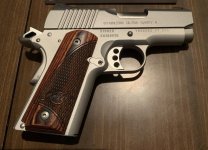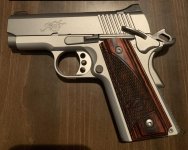I own seven Kimber’s including these 1911s:
- Gold Match II, .45 ACP
- Custom CDP II, .45 ACP
- Pro Carry II, 9mm Luger
- Ultra Carry II, .45 ACP
Three of the, shown here:
——
Here is my take on them.
1) They are well made . They are mid tier. More expensive than RIA and similar 1911s, and about the same as Springfield Armory and Ruger 1911s, unless you start adding on lots of options.
2) They are very reliable:
a) once you break them in (about 200-500 rounds);
b) provided you use a decent magazine, appropriate for the bullet you are using. (I’ve talked about 1911 .45 ACP magazines here before. Kimber, like most other 1911 manufacturers, uses a Colt Commerial/Hybrid style magazine with semi tapered feed lips. It’s designed to work well with both RNFMJ and hollow points as well as FNFMJ and some of the longer semi wad cutter bullets. If you don’t understand why, do a search and read up on the different magazine lip types). The Kimber magazines are very well made and work great with pretty much any factory ammo. If you shot something odd (like really short, light weight semi wad cutters) you might need something else;
c) provided you don’t try to “upgrade it”. The 4” and in particular 3” models have a comparatively short slide over run. One of the biggest mistakes people make with them is installing a shock buffer and or a “extra power recoil spring. Unless you have a degree in engineering and some experience designing 1911s, don’t go screwing around with your new Kimber by adding “upgrades” like shock buffers and extra power recoil springs. A shock buffer further reduces slide over run and will cause feed problems. An extra power recoil spring will mess with the dwell time and slide velocity of the slide and cause feed issues. An extra power recoil spring will also result in the slide coming into battery with excessive velocity and will batter the frame, especially on aluminum frame guns;
d) provided you replace the recoil springs at the specified intervals for the various models (which varies from 800 to 1200 rounds). If you can’t remember the number, just go with 800 rounds. Once you’ve shot a 1911 while, you’ll also notice if the recoil starts to feel a bit “metallic” with the slide bottoming out on the frame under recoil. That’s your sign the recoil spring is worn out, regardless of round count; and
e) provided you run it wet. It’s a 1911, not tactical Tupperware wear like a Glock. Glocks run fine mostly dry, 1911s do not. Don’t be afraid to be generous with the oil. It won’t attract dirt, etc.
3) The Schwartz firing pin system on the “II” models works fine and with close to 100,000 rounds through my various Kimber 1911s I’ve never had one fail. But that’s because I am not an idiot and I read the manual.
The system has a small stud in the frame that comes up when you depress the grip safety. Many shooters learn to field strip a 1911 with a 1911 using the original or Series 70 design with no grip safety. Most of these shooters have a bad habit of reinstalling the slide on the frame by gripping the grip in their manly hands and then sliding the slide back on the frame. In the process they depress the grip safety, the stud comes up and the frame impacts the stud. Some of them, being clueless morons do what they just did, but harder, and then even harder until they brute force the slide over the stud. Then, when they eventually break the stud and the pistol fails to disengage the grip safety, being morons, they blame Kimber and the Schwartz system. If you take care not to depress the grip safety, and in some cases, take your finger and push the stud down into the frame before installing the slide, you’ll never have a problem and will never break the firing pin safety system.
As an aside, Schwartz worked for Colt and Colt planned to adopt the system on all of their 1911s just prior to WWII. The War Department asked them not to, as they were in the process of planning to order a lot more 1911A1s with WWII on the horizon and did not want two types of pistols with different parts in the inventory. After WWII Colt used left over military contract pistols and slides in its commercial pistols for a few years, and by then sales were slow as the world was awash in surplus 1911s. Colt didn’t do a serious redesign until 1970 and left the firing pin safety feature off. By the time they did the Series 80 redesign, Kimber was building their own 1911s using Colt’s expired patents for the Schwartz system and Colt went with the trigger activated design.
——
In short, the vast majority of the “reliability” complaints you hear about Kimber’s are made by “ a guy who knows a guy who said…” and *that guy* either tried to upgrade it before he ever shot it, and/or used the wrong magazine with it, and/or didn’t break it in first, and/or didn’t lube it properly. Don’t be that guy, if you do decide to be that guy, don’t blame Kimber.



